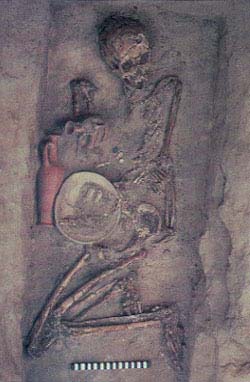Image Details

Carl Andrews, courtesy Leon Levy Expedition
The Canaanite way of death. An adolescent Canaanite girl lies in a flexed position in a mudbrick-lined vault covered with wooden boughs and coated with white plaster, dating to about 1500 B.C. At her shoulder the excavators found two toggle pins, for fastening a garment; three Egyptian scarabs and an ivory roundel lay on her midsection. The burial also contained Syrian and Cypriot pottery.
The scarabs and the Cypriot pottery imports helped excavators date the burial to about 1500 B.C., indicating that Ashkelon had revived after the Egyptians destroyed parts of the seaport about 50 years earlier. The custom of burying within the city, rather than in a cemetery outside it, and the mudbrick-lined vault are continuations of Middle Bronze II (2000–1550 B.C.) Canaanite burial traditions.
